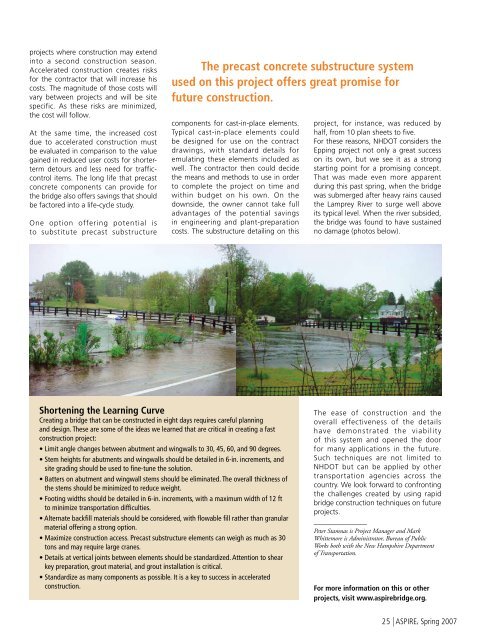ASPIRE Spring 07 - Aspire - The Concrete Bridge Magazine
ASPIRE Spring 07 - Aspire - The Concrete Bridge Magazine
ASPIRE Spring 07 - Aspire - The Concrete Bridge Magazine
Create successful ePaper yourself
Turn your PDF publications into a flip-book with our unique Google optimized e-Paper software.
projects where construction may extend<br />
into a second construction season.<br />
Accelerated construction creates risks<br />
for the contractor that will increase his<br />
costs. <strong>The</strong> magnitude of those costs will<br />
vary between projects and will be site<br />
specific. As these risks are minimized,<br />
the cost will follow.<br />
At the same time, the increased cost<br />
due to accelerated construction must<br />
be evaluated in comparison to the value<br />
gained in reduced user costs for shorterterm<br />
detours and less need for trafficcontrol<br />
items. <strong>The</strong> long life that precast<br />
concrete components can provide for<br />
the bridge also offers savings that should<br />
be factored into a life-cycle study.<br />
One option offering potential is<br />
to substitute precast substructure<br />
<strong>The</strong> precast concrete substructure system<br />
used on this project offers great promise for<br />
future construction.<br />
components for cast-in-place elements.<br />
Typical cast-in-place elements could<br />
be designed for use on the contract<br />
drawings, with standard details for<br />
emulating these elements included as<br />
well. <strong>The</strong> contractor then could decide<br />
the means and methods to use in order<br />
to complete the project on time and<br />
within budget on his own. On the<br />
downside, the owner cannot take full<br />
advantages of the potential savings<br />
in engineering and plant-preparation<br />
costs. <strong>The</strong> substructure detailing on this<br />
project, for instance, was reduced by<br />
half, from 10 plan sheets to five.<br />
For these reasons, NHDOT considers the<br />
Epping project not only a great success<br />
on its own, but we see it as a strong<br />
starting point for a promising concept.<br />
That was made even more apparent<br />
during this past spring, when the bridge<br />
was submerged after heavy rains caused<br />
the Lamprey River to surge well above<br />
its typical level. When the river subsided,<br />
the bridge was found to have sustained<br />
no damage (photos below).<br />
Shortening the Learning Curve<br />
Creating a bridge that can be constructed in eight days requires careful planning<br />
and design. <strong>The</strong>se are some of the ideas we learned that are critical in creating a fast<br />
construction project:<br />
• Limit angle changes between abutment and wingwalls to 30, 45, 60, and 90 degrees.<br />
• Stem heights for abutments and wingwalls should be detailed in 6-in. increments, and<br />
site grading should be used to fine-tune the solution.<br />
• Batters on abutment and wingwall stems should be eliminated. <strong>The</strong> overall thickness of<br />
the stems should be minimized to reduce weight.<br />
• Footing widths should be detailed in 6-in. increments, with a maximum width of 12 ft<br />
to minimize transportation difficulties.<br />
• Alternate backfill materials should be considered, with flowable fill rather than granular<br />
material offering a strong option.<br />
• Maximize construction access. Precast substructure elements can weigh as much as 30<br />
tons and may require large cranes.<br />
• Details at vertical joints between elements should be standardized. Attention to shear<br />
key preparation, grout material, and grout installation is critical.<br />
• Standardize as many components as possible. It is a key to success in accelerated<br />
construction.<br />
<strong>The</strong> ease of construction and the<br />
overall effectiveness of the details<br />
have demonstrated the viability<br />
of this system and opened the door<br />
for many applications in the future.<br />
Such techniques are not limited to<br />
NHDOT but can be applied by other<br />
transportation agencies across the<br />
country. We look forward to confronting<br />
the challenges created by using rapid<br />
bridge construction techniques on future<br />
projects.<br />
_____________<br />
Peter Stamnas is Project Manager and Mark<br />
Whittemore is Administrator, Bureau of Public<br />
Works both with the New Hampshire Department<br />
of Transportation.<br />
For more information on this or other<br />
projects, visit www.aspirebridge.org.<br />
25 | <strong>ASPIRE</strong>, <strong>Spring</strong> 20<strong>07</strong>

















